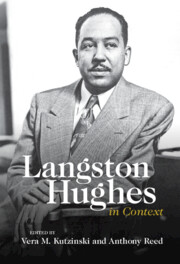Book contents
- Langston Hughes in Context
- Langston Hughes in Context
- Copyright page
- Contents
- Contributors
- Abbreviations
- Introduction
- Part I Singing America
- Chapter 1 Langston Hughes, Chicago, and Modernism
- Chapter 2 Jazz, Performance, and Modernist Embodiment in Langston Hughes’s Early Writing
- Chapter 3 His Ways with White Folks
- Chapter 4 Love at a Distance in Selected Letters by Langston and Carrie Hughes
- Chapter 5 Langston Hughes’s 1930s Short Fiction
- Chapter 6 Langston Hughes and Simple
- Chapter 7 Langston Hughes’s Famous Books, Ebony Magazine, and the Politics of Civil Rights in Biographies for the Young
- Chapter 8 Rural Black Masculinity and the Blues in Not without Laughter
- Chapter 9 From the Sublime to the Grotesque
- Chapter 10 Coalitional Aesthetics
- Chapter 11 Langston Hughes’s Translingual Poetics and Pedagogy
- Part II The Global Langston Hughes
- Part III Afterlives
- Index
Chapter 2 - Jazz, Performance, and Modernist Embodiment in Langston Hughes’s Early Writing
from Part I - Singing America
Published online by Cambridge University Press: 10 November 2022
- Langston Hughes in Context
- Langston Hughes in Context
- Copyright page
- Contents
- Contributors
- Abbreviations
- Introduction
- Part I Singing America
- Chapter 1 Langston Hughes, Chicago, and Modernism
- Chapter 2 Jazz, Performance, and Modernist Embodiment in Langston Hughes’s Early Writing
- Chapter 3 His Ways with White Folks
- Chapter 4 Love at a Distance in Selected Letters by Langston and Carrie Hughes
- Chapter 5 Langston Hughes’s 1930s Short Fiction
- Chapter 6 Langston Hughes and Simple
- Chapter 7 Langston Hughes’s Famous Books, Ebony Magazine, and the Politics of Civil Rights in Biographies for the Young
- Chapter 8 Rural Black Masculinity and the Blues in Not without Laughter
- Chapter 9 From the Sublime to the Grotesque
- Chapter 10 Coalitional Aesthetics
- Chapter 11 Langston Hughes’s Translingual Poetics and Pedagogy
- Part II The Global Langston Hughes
- Part III Afterlives
- Index
Summary
In this chapter, I return to Hughes’s early jazz-inspired writing with an eye to his crucial awareness of music and embodiment as combined within African American contributions to modernism, and critical to an emboldened new Black subjectivity after World War I. Associations between music, the body, and Black subjectivity are key to conceptualizing Hughes’s Black modernist style on its own terms – that is, without only looking for points of correspondence in literary form with the work of his white canonical counterparts. Thus, I root my discussion of Hughes’s work in critical understandings of jazz, Black musical aesthetics, and performance that privilege uses of the body. As I argue, Hughes’s vision for a decidedly Black modernist aesthetic depended always on his acute understanding of the radical effects of African American performance strategies and his appreciation for jazz not just as an innovation on musical form but also as an embodied counterpoint to the discursive and the semantic as privileged modalities.
- Type
- Chapter
- Information
- Langston Hughes in Context , pp. 21 - 32Publisher: Cambridge University PressPrint publication year: 2022

